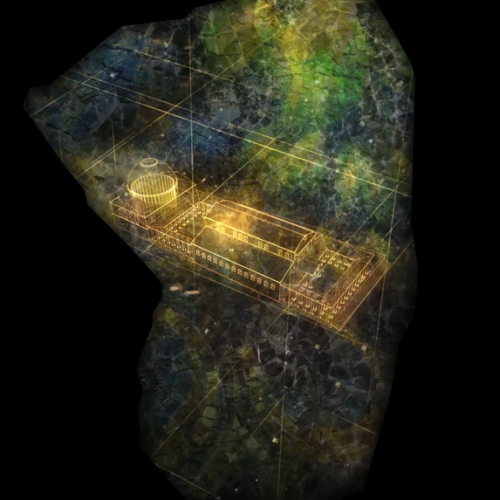Concept & design
A multimedia installation grants visitors an aesthetic, authentic experience, one that reveals to them Jerusalem’s historical, urban and cultural development. An orchestrated modern, narrative, multi-medial layer is added to the authentic location: the Lapidarium hall at the Monastery of the Flagellation.
Visitors are immersed in the past and closely experience Jerusalem’s history, from Herod the Great to the pilgrims of today, in timed audiovisual layers dismantling time and space.
The exhibition is divided into three stages:
1. ARCHAEOLOGICAL FRAGMENTS – A SENSORIAL AND EMOTIONAL EXPERIENCE
CONTENT / from Herodian Jerusalem to Aelia Capitolina (Hadrianic era)
OBJECTS / archaeological fragments, the inside of the building
In the first phase an all-engulfing, atmospheric moment created by sound and moving light immerses the visitor and provides a highly sensorial and emotional experience. The voice of ancient Jerusalem leads the visitor through the content of the installation, and at the same time raises awareness of the historical importance of the location and its remains.
The intention is to reveal the significance of the site as a station on the Way of the Cross, as well as to highlight the archaeological fragments inside the building. This sets the atmosphere and invites visitors to enter another reality.
2. PROJECTION MAPPING
CONTENT / Jerusalem’s historical and urban development, from the times of Jesus to the city of today
OBJECTS / city model, projection mapping, film, animations, drawings
The second phase features the key-element and main attraction of the installation: a topographical model of the city of Jerusalem that, hanging from the ceiling in an almost disembodied manner, serves as an impressive surface for projection mapping.
Video, sound and projection mapping form a narrative unity, a memory machine that sends visitors on a poetic journey. The video features images of crucial moments in the city’s history, ranging from geographical maps of Jerusalem’s urban development to religious and historical facts. Almost all image sources used for the installation belong the Franciscan order.
3. SHADOWS OF LIGHTS OF THE ANCIENT PILGRIMS
CONTENT / quotes from illustrious pilgrims
OBJECTS / projections of shadows of light on the rock and on the walls
The pilgrims themselves, represented as shadows of light, are the stars of the third phase. Their voices and their prayers, coming from the past and the present, are whispered to the visitors. A spiritual atmosphere is evoked here; at the end, visitors are encouraged to walk the Via Dolorosa, and thus to join a century-old tradition of pilgrimages.
The VIA DOLOROSA Museum from Tamschick Media+Space GmbH for the Terra Sancta Museum on Vimeo.







